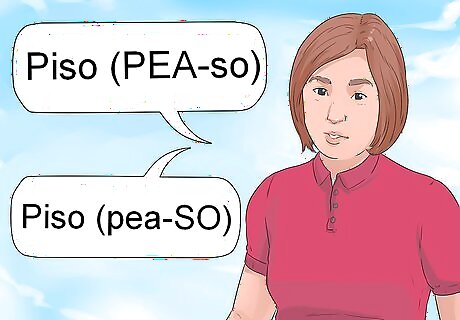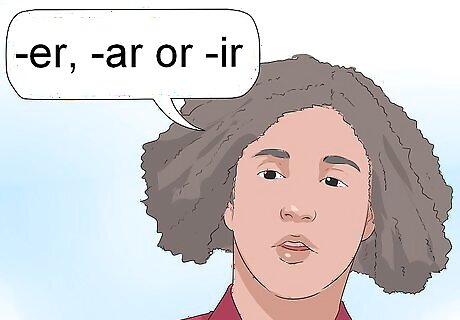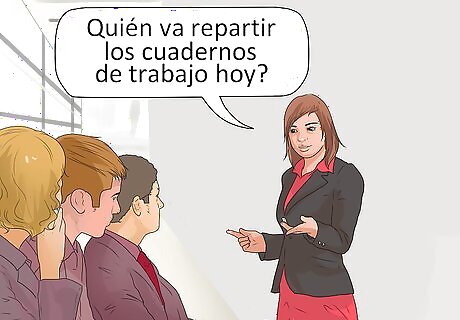
views
Covering the Basics

Teach pronunciation first. One foundation that teachers won’t want to forget is pronunciation. Students often have significant problems with pronunciation that can interfere with the rest of their learning. Take time to tackle the sounds of the various Spanish vowels and consonants before going onto more involved lessons. Students having English as their first language shouldn’t be afraid of Spanish phonetics because they’re going from a very complex system into a much simpler one. Vowels in Spanish do not vary in length or pitch, and when a variation occurs it is not meaningful. Much of Spanish pronunciation is phonetic (things are pronounced the way they look), although students may struggle to become familiar with the Spanish “r” sound (rolled on the top of the mouth) and the fact that “ll” is pronounced as a “y” sound.

Focus on the pronunciation of accents and stress marks in words. Stress, however is of paramount importance since a differing stress can change a word entirely. Connected with stress are weak forms, (word level) and rhythm (sentence level). Again, English speaking students are in luck again, as the Spanish system is easier than the English system. For example, “piso” (pronounced “PEA-so”) means “I tread,” “floor,” and “apartment.” “Pisó” (pronounced “pea-SO”): “s/he/it treaded,” leading to misunderstandings in both languages if not mastered properly. Compare the English words “command” & “transfer” when you shift the stress, to show students the difference between stressing the second syllable or the first syllable. Spanish is a relatively easy language to learn (especially when compared to the thorny English language with its incongruous spellings and word meanings).

Handle verb conjugations. One of the most significant concepts in teaching Spanish is conjugating verbs and helping students to understand how these words change with tenses and use. Most of the Spanish verbs are regular, having either an -er, -ar or -ir verb form. Make sure students master the common verb forms, and they will be on their way to a better understanding of the language as a whole. Show students online resource and websites that show conjugation charts. Make it clear to the students that these are foundational, and they need to memorize regular verb conjugations, as well as the irregular verbs. Explain that verb tenses in Spanish are conjugated with who is doing the action or subject. Depending on the pronoun, Spanish has both formal and informal ways to address another person (which will affect conjugation).

Go over irregular verbs like “ir.” Much like English, Spanish has a substantially irregular verb form for “to go,” translated “ir.” Include the word changes from “ir” to “va” (you [forma] go) and “fue” (he went), etc. in beginning verb conjugation. This is a crucial verb that students simply need to memorize.
Developing Pronouns and Vocabulary

Teach informal and formal pronouns as necessary. Another large portion of basic Spanish language teaching is the pronouns. Students may want to know only the informal, or only the formal pronouns. Use discretion in how the pronouns are approached, but make sure students know how to use them in any case. Spanish, unlike English, has both an informal “you” (tu) used when speaking to peers, and a form “you” (usted), used when speaking to elders. Clarify to students when they should use each form, but encourage use of “tu” in the classroom. You will also need to teach students gender, as nouns in Spanish have either masculine or feminine gender.

Provide vocabulary for common situations. It’s important to bulk up your students’ vocabulary memorization through their classroom years. Rather than teach them esoteric vocabulary, focus on easily-applicable words that are relevant to their lives. Think about the specific needs of a student group. Spanish has many cognates (words that have similar sound and meaning) with English. For example, you students can easily tell what “hamburgesa” means. This is where many experienced Spanish language teachers talk about Spanish for tourism, Spanish for work, or discipline-specific vocabulary. Since you are teaching students, it can be useful to teach vocabulary related to school supplies and academic studies. Also teach vocabulary related to common interests for teens: food, technology, music popular media (TV and film), etc.

Focus the classroom on speaking Spanish. While students to need to be able to read written Spanish and write in Spanish, the learning will feel more engaging for them if they regularly speak in the classroom. Encourage your students to make mistakes and try for more complex phrases and ideas. Correct your students if they make serious or frequent errors, but in general, your role should be to encourage students and push them forwards, not to criticize them.

Teach full sentences and common expressions. Teachers should aim at teaching full sentences, as students will be unable to communicate (at any level) if they are only familiar with unconnected vocabulary words and verb-conjugation charts. Give your students common expressions like: ¿Quién va repartir los cuadernos de trabajo hoy? (“Who is going to distribute the workbooks today?”) ¿Alguien ha visto un texto en Español de camino al Colegio? (“Has anyone read a text in Spanish on their walk to school?”) ¡Venga, que tenemos mucho trabajo! (“Come, we have a lot of work!”) ¡Vaya trabajo chapucero, lo siento pero vas a tener que repetirlo! (“You’ve done sloppy work, I’m sorry but you’re going to have to repeat it!”) ¡Muy bien, cada día trabajas mejor! (“Very good, each day you’re doing better work!”)
Expanding Your Teaching Methods

Vary classroom activities. For the most effective Spanish teaching, professionals recommend going from “closed” to “open” activities, where teachers first teach the vocabulary (“closed”), then break the students up into groups and allow them to use it in practice (“open”). Books on “Teaching Games” and “Role Playing” are helpful. For instance, “Who’s Who” is a game that provides plenty of activity. This kind of approach often promises to deliver plenty of Spanish language/culture skills to students. Divide students up into pairs or small groups, and ask them to have a short conversation. More experienced students may be able to act out a short, funny skit in Spanish.

Bring Spanish or Mexican culture into the classroom. Especially if you are teaching students who may one day travel to a Spanish-speaking country, it’s valuable to familiarize students with Mexican, Latin American, and Spanish culture. (This also provides a great opportunity to present new vocabulary.) You can also bring in Spanish-language media, such as popular films or music. Inform your students about: Common national foods of Mexico and Spain. Mexican holidays, like Day of the Dead. Pronunciation differences between Mexican/Latin American and European Spanish (including the Castilian “lisp”).

Tailor teaching to the skill level of a student group. Basic students will want to know the very basic items like verbs, pronouns, and introductory vocabulary. More advanced students will want to be taught how to use Spanish in different situations, and even some Spanish vernacular (as their level allows). Put items like numbers, days of the week and colors up front. These helpful single words are used in a vast variety of situations, and when students get these lists in their head, they are more able to form Spanish sentences. Rhymes and songs are powerful tools to convey them.

Encourage students to speak Spanish in the classroom. Especially with earlier levels of Spanish, you will need to introduce new concepts, vocabulary, tenses, and conjugations in English. However, having your students speak Spanish as often as possible will improve both their familiarity with the language and their pronunciation. Once students can speak enough Spanish to be conversant—usually around their third year of high-school Spanish—you can mandate that students speak only Spanish in your classroom. At this point, your students will understand the language well enough that you will not need to speak English to them at all.




















Comments
0 comment